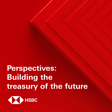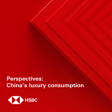Become a Creator today!Start creating today - Share your story with the world!
Start for free
00:00:00
00:00:01

The Macro Brief – What's driving bonds?
Steven Major, Global Head of Fixed Income Research, explains how both cyclical and secular forces contribute to the outlook for the bond market.
Disclaimer: https://www.research.hsbc.com/R/101/vhshHRp.
Stay connected and access free to view reports and videos from HSBC Global Research follow us on LinkedIn https://www.linkedin.com/feed/hashtag/hsbcresearch/ or click here: https://www.gbm.hsbc.com/insights/global-research.
Hosted on Acast. See acast.com/privacy for more information.
Transcript
Introduction and Purpose
00:00:02
Speaker
Welcome to HSBC Global Viewpoint, the podcast series that brings together business leaders and industry experts to explore the latest global insights, trends, and opportunities.
00:00:13
Speaker
Make sure you're subscribed to stay up to date with new episodes.
00:00:16
Speaker
Thanks for listening.
00:00:17
Speaker
And now onto today's show.
Podcast Context and Disclaimers
00:00:24
Speaker
This podcast was recorded for publication on the 19th of July, 2024 by HSBC Global Research.
00:00:29
Speaker
All the disclosures and disclaimers associated with it must be viewed on the link attached to your media player.
00:00:34
Speaker
And don't forget, you can follow us wherever you get your podcasts.
00:00:36
Speaker
Just search for The Macro Brief.
00:00:41
Speaker
Hello, I'm Piers Butler and welcome to The Macro Brief.
00:00:44
Speaker
As the benchmark for the government bond market, US treasuries are closely watched by investors and the media alike.
00:00:50
Speaker
But what are the most important factors influencing treasuries?
US Treasuries: Short vs. Long-term Influences
00:00:54
Speaker
A lot of comment focuses on short-term factors such as data releases.
00:00:59
Speaker
But should we all be paying closer attention to longer-term drivers such as demographics?
00:01:03
Speaker
Steve Major, our global head of fixed income research, joins us from Dubai to discuss the things about bonds.
00:01:09
Speaker
Steve, welcome to the podcast.
00:01:11
Speaker
Thanks for having me, Piers.
00:01:12
Speaker
Firstly, Steve, I just wanted to talk about your regular publication, the appropriately called Major Bond Letter.
00:01:21
Speaker
which actually listeners can get hold of by following you on LinkedIn, and which broadly aims to demystify the sometimes complex topic of bonds.
00:01:31
Speaker
Yeah, I think that's a good description, Piers.
00:01:34
Speaker
It's one of those where it's two pages long, so it's not as deep as some of our thematics or some of our asset allocation pieces.
00:01:44
Speaker
But it's targeted, really, at an audience who wants to get access to the content
00:01:51
Speaker
the important things about bonds and and for me there's there's sometimes too much complexity and i think that we as analysts might be guilty of adding to that to tell you the truth but i'm just trying to get to to what what matters what what the key themes are what's driving bonds and uh sometimes it's actually more challenging for me to write just two pages than 20 but but there you go
00:02:17
Speaker
That's often the case.
Understanding Long-run Equilibrium and R Star
00:02:18
Speaker
And in fact, in your latest one, you highlight this current divergence between short-term U.S. Treasury rates and the long-run equilibrium.
00:02:27
Speaker
So what do you mean by the long-run equilibrium and why the divergence?
00:02:32
Speaker
Sometimes in markets, it's called the R star and it's the real natural rate.
00:02:37
Speaker
This is some point in the future, which could be at least five years or so, whereby the economy has full employment and inflation is at the target.
00:02:48
Speaker
So it's a completely theoretical concept, but it's useful for central bankers and analysts to have some kind of anchor like this, because when the policy rate is...
00:02:59
Speaker
higher then it's restrictive when it's higher than this equilibrium it's restrictive when it's lower as it has been then it's accommodating this uh this neutral rate moves through time but very slowly because there are secular forces that explain why it moves which is very different to what many people in the market are focusing on every day which by the way is not wrong
00:03:24
Speaker
It's the data, it's the incoming data, but the incoming data is really about cycles, near-term cycles that are moving within very short-term periods.
00:03:36
Speaker
So it's necessary to have both, an eye on the near-term cyclical drivers at the policy rate, and then the longer-run equilibrium.
Short-term Trends vs. Long-term Valuation
00:03:45
Speaker
But is the point that you're making that looking at the extent of that divergence, that perhaps the market is too focused on the short term and should be maybe paying a little bit more attention to some of these longer running secular trends?
00:04:00
Speaker
Yeah, and I think it's also a response to the feedback I get in client meetings, because when the majority of the questioning is on the next CPI or payrolls release or next move from the central bank,
00:04:15
Speaker
it tells you what people are thinking but but for me if you want to value a 10-year security you need to think about discount rates over the next decade because that's how you value a bond
00:04:30
Speaker
A bit like for the equity market, you need to have an eye on what the long run rates are to input into your models.
00:04:38
Speaker
Well, it's the same with a bond.
00:04:39
Speaker
You cannot value a 10-year security with the policy rate.
00:04:43
Speaker
You need to know where it's going.
00:04:45
Speaker
So having...
00:04:46
Speaker
A view of the equilibrium is something that we are all doing, whether we know it or not.
00:04:51
Speaker
So it's conscious or subconscious.
00:04:54
Speaker
Every investor and analyst is taking a view on the longer-run equilibrium when they're talking about 10-year yields.
Demographics as a Secular Driver
00:05:02
Speaker
Now you and your team published a report looking at some of these longer-run secular drivers.
00:05:08
Speaker
In it you say that demographics is the most important secular driver of bond markets.
00:05:14
Speaker
Can you explain to us why that is?
00:05:16
Speaker
Yes, so the Bank of England claimed it was the biggest factor in a recent report.
00:05:22
Speaker
Also when people talk about the various determinants of longer-run equilibrium, demographics is top of the list.
00:05:30
Speaker
And I think that there are many reasons for this.
00:05:34
Speaker
And it's to do with the life cycle hypothesis and the idea that people save whilst they're working and then they start to deaccumulate in retirement, that kind of thing.
00:05:50
Speaker
and therefore some people are taking a view based on that that something is changing as the as the population ages and dependency ratios shift dependency ratios are the proportion of people who are not working so they're retired or too young divided by the people that are of working age so so that is a key theme that hsbc has looked at
00:06:16
Speaker
But for me, the demographics and bonds requires a lot of thought because there are many moving parts.
00:06:25
Speaker
One, it's global.
00:06:26
Speaker
And two, we've got to bring in all different areas of behavior.
00:06:32
Speaker
And that involves credit formation, deleveraging,
00:06:37
Speaker
people wanting to bequest what's happening to our longevity, how people in retirement start to hedge the tail risk that they might live longer than they thought.
00:06:49
Speaker
So there's all kinds of factors, Piers.
00:06:52
Speaker
And Steve, you make another bold claim, and that is that credit creation matters and that academic literature often overlooks this.
Credit Creation, Aging, and Migration
00:07:00
Speaker
Yeah, so...
00:07:03
Speaker
It seems that many people in the market have an opinion that things might have changed, and some of the academic work was released before the pandemic.
00:07:13
Speaker
and the idea was that populations are aging they'll be dis saving and with aging populations higher dependency ratio wages could go up because of the lack of people to look after the old people and um it seems like that view might have been right for the wrong reason because inflation went up very quickly due to the supply chain shocks during the pandemic we've taken it apart and looked at all the various factors here
00:07:41
Speaker
now credit creation is one of the interesting ones because boomers these are the the baby boomers from after the second second World War they they would have uh taken on mortgages which gave them leverage to accumulate assets and they're not going to be doing that in retirement so so you get some of the opposite effect
00:08:04
Speaker
So it could be that there is a distortion in the data because of the surge in previous credit creation.
00:08:14
Speaker
The other thing about this, which is very global, is that
00:08:18
Speaker
if we look at individual countries we're missing migration of people from one country to another and we're missing the movement of capital from one place to another so imagine that there is a part of the world that needs to save because it's got a young population now i'm thinking here about the gcc region and you can say india parts of africa those young people need to save and they have to find assets to save them now it could it could well be for example that they choose dollars
00:08:48
Speaker
for lack of alternative products locally.
00:08:51
Speaker
So you have migration of money and migration of people.
00:08:54
Speaker
And one of the best examples that we point out is the UK Health Service.
00:08:58
Speaker
You can see the nature of the people working in the health service, a big shift towards Southeast Asia, whilst EU employees of origin from the EU declining.
00:09:10
Speaker
Similar things happening in the US, thanks to migration, that has actually put a cap on wages when
00:09:17
Speaker
Many were thinking that wages would surge because there'd be a lack of people.
00:09:21
Speaker
So a simple response is it's dynamic, Piers.
00:09:25
Speaker
Money and people flow to the places where there's value and demand.
Global Economic Shifts and Disinflation
00:09:31
Speaker
One of the big disinflationary forces of the global economy in the last three decades, as you point out, has been China and its entry into the global markets.
00:09:42
Speaker
So as that economy matures, does that disinflationary force disappear or is it being replaced by something else?
00:09:52
Speaker
Yeah, it would be reasonable to say on a static analysis that
00:09:57
Speaker
that China has matured and evolved such that it's not contributing the cheap goods that it was in the past.
00:10:04
Speaker
So therefore, as a disinflationary force, it's much less today than it was 10 and 20 odd years ago when it joined the WTO.
00:10:13
Speaker
Can't really argue with that because China is going up the value chain.
00:10:18
Speaker
The cheap products that it exported were possible because of huge amounts of people moving from farms, from rural communities to urban communities.
00:10:29
Speaker
So that's the theory that China would stop exporting disinvasion.
00:10:36
Speaker
But here we are post-pandemic, and it actually doesn't seem to have happened, by the way.
00:10:41
Speaker
But our point was that there are many other countries that are doing the same thing.
00:10:47
Speaker
and you can think about India, Mexico and Vietnam.
00:10:52
Speaker
They're three of the countries we mentioned.
00:10:54
Speaker
So you need the right combination of young population moving from the rural areas to cities wanting to do these jobs.
00:11:02
Speaker
And you have to have the right combination of governance as well.
00:11:05
Speaker
But our point is, there are many billions of people waiting to fill the shoes of the Chinese population that was doing this in the past.
00:11:17
Speaker
It's evidence based as well, Piers.
00:11:19
Speaker
It doesn't seem, one, that China has stopped exporting disinflation, but also the evidence is that manufacturing is moving to other places where it's cheap.
00:11:31
Speaker
And what about
Japanification and Global Lessons
00:11:33
Speaker
Japan?
00:11:33
Speaker
Obviously, there's a lot of deflation in Japan.
00:11:36
Speaker
What lessons can we learn from looking at that market?
00:11:39
Speaker
It's not so long ago that we were writing about the Japanification.
00:11:44
Speaker
Jamie Stoddard, my colleague, tells me that people were talking about Japanification of the West a long time ago, maybe as long as 15 years ago, but we wrote about it in 2018-2019 at a time when German government bond yields went underneath the Japanese equivalents.
00:12:02
Speaker
Now, of course, they're not there now, but Japanification of the Eurozone was a big theme pre-pandemic, and Japanification
00:12:12
Speaker
that japan is a lesson really what happens after a boom turns to bust that in japan's case it was due to property had a big impact on the banks big impact on confidence and it's interesting how how this could be playing out in other parts of the world today in many ways that the excessive leverage
00:12:37
Speaker
of of the past is funny enough linked to the demographics today because if um uh confidence is lost um then young people don't go buy houses they end up staying at home and actually it has an impact on the birth rate so when we talk about Japanification and demographics that's where I'm going
00:12:59
Speaker
There's also the zombification of companies and corporates.
00:13:04
Speaker
We've seen that as well, whereby because of the low rates and keeping rates low for a very long time, you don't get the creative disruption that you would have in a normal rate cycle.
00:13:15
Speaker
So there's many lessons from Japan that have played out.
00:13:19
Speaker
That we should basically be paying attention to on a
Inflation Narratives and Real GDP Focus
00:13:23
Speaker
more global basis.
00:13:23
Speaker
I want to bring it back to the short term.
00:13:28
Speaker
Where do we stand on inflation?
00:13:32
Speaker
In one of your major bond letters, you talk about a narrative fallacy.
00:13:35
Speaker
What do you mean by that?
00:13:36
Speaker
I took that from the book by Nassim Taleb.
00:13:41
Speaker
So that's the thought by randomness.
00:13:45
Speaker
and he refers to how it's been possible for the media to take an event and have on the same day two different views of that event and we're seeing that sometimes around inflation some people think it's sticky some think it's moving back to target i think in addition to the the fallacy effects so different interpretation of the same news
00:14:11
Speaker
You can also have a transition in the narrative.
00:14:15
Speaker
And what I think is going on at the moment is that we're gradually transitioning away from inflation because inflation has been falling the last few months and moving back towards target and more more of a weight is going on to other things like the real the real GDP.
00:14:33
Speaker
Now, my point in all of this is that when you're looking at bonds, it's not just CPI and real GDP.
00:14:40
Speaker
It's also the longer run equilibrium.
00:14:43
Speaker
And central banks have to have one eye on financial stability as well, for example.
00:14:49
Speaker
So the idea of narrative fallacy is that just because everyone's talking about the same thing doesn't make it right.
00:14:57
Speaker
Very true indeed, as I've experienced on many occasions in the markets.
Bond Strategies and Market Asymmetry
00:15:02
Speaker
Can we finish on this point that you make that on balance with bonds, you might be better off.
00:15:09
Speaker
doing nothing.
00:15:10
Speaker
You do this exercise in one of the Bonn letters of shocking the yield curve and illustrating how, yeah, you would be better off basically waiting.
00:15:19
Speaker
Yeah, so there are all kinds of different investors.
00:15:22
Speaker
Some are more dynamic than others.
00:15:24
Speaker
And you can think about the range of traders and hedge funds compared with pension funds and life insurance companies that just buy and hold.
00:15:34
Speaker
My point is that with the higher interest rates, we've seen the restoration of coupons.
00:15:41
Speaker
uh to bonds across the curve and in in credit markets in investment grade credit you can you can get 100 basis points or more extra on top of the sovereign so that means it's it's quite possible to to sit with uh with a yield to maturity of between five and six percent and my argument is if nothing happens that's not bad uh you're going to be in a in in a pretty strong position if you can if you can
00:16:14
Speaker
where it is you're going to have a positive real yield but of course my point was that if the yield was to go up 100 basis points you would of course lose some some capital but you're compensated by the receipt of the coupon which is a much more decent level than it was only a few years ago now of course if yields fall a lot then there's capital gain plus coupon so it seems to me there is an asymmetric bias to the setup and i'll just complement that point with um by saying that
00:16:43
Speaker
that policy rates are most likely going to be unchanged or down in the coming months because that's what central banks seem to be guiding so for for an investor sitting in bonds and being patient seems to make sense given the asymmetry in the outlook
00:17:02
Speaker
Well, I hope that this has given the listeners a flavor of the major bond letters.
00:17:08
Speaker
As I said at the start, you can find them by following Steve on LinkedIn.
00:17:14
Speaker
And as we said, they really, I think, personally demystify the sometimes complex subject of bonds and give the big picture.
00:17:22
Speaker
So, Steve, thank you very much for sharing that with us.
00:17:25
Speaker
Thank you, Piers.
00:17:28
Speaker
So that wraps things up for today.
Conclusion and Contact Information
00:17:30
Speaker
Don't forget that if you have any questions on global research, email us at askresearch at hsbc.com.
00:17:37
Speaker
From all of us here, thanks for listening.
00:17:39
Speaker
We'll be back again next week.
00:17:58
Speaker
Thank you for joining us at HSBC Global Viewpoint.
00:18:01
Speaker
We hope you enjoyed the discussion.
00:18:04
Speaker
Make sure you're subscribed to stay up to date with new episodes.
















